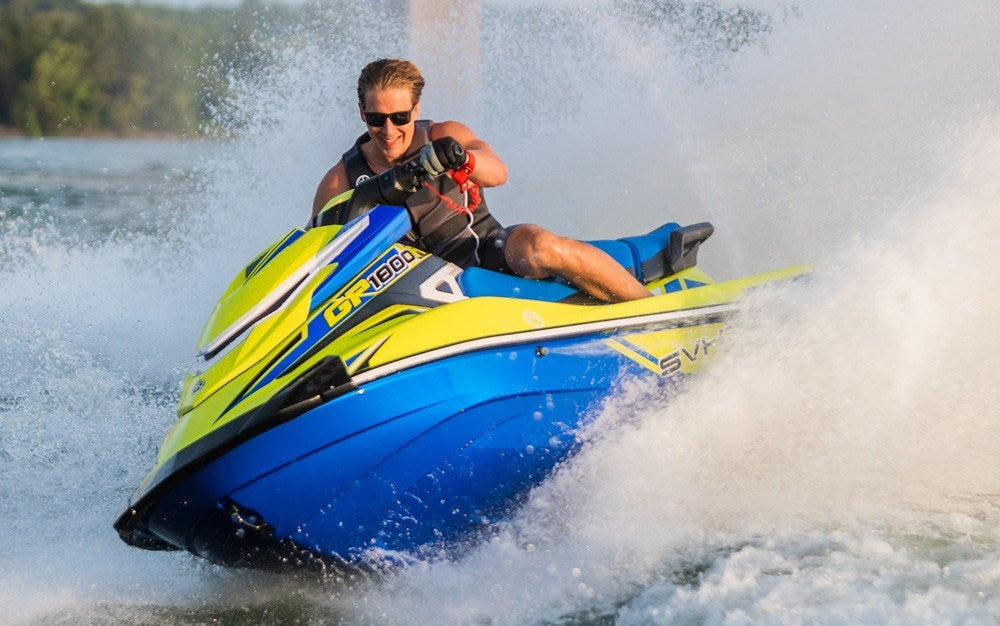2020 Yamaha GP 1800R SVHO Review
The very definition of a race-ready PWC
Yamaha’s GP 1800R was one of the hottest performance boats on the water in 2019, both from a competitive and hardcore recreational standpoint. Nevertheless, for 2020 it gets a tweak — a new name. Now that the former VXR has been renamed the GP1800R HO (a nod to the naturally aspirated 1,812cc HO engine occupying the engine compartment) the former GP 1800R now becomes the 2020 Yamaha GP 1800R SVHO (to reflect, what else, the supercharged/intercooled SVHO variation of that same engine).
Engine: Four-cylinder 1,812cc Supercharged/Intercooled
Fuel Capacity: 18.5 gal.
Stowage Capacity: 24.6 gal.
Seating Capacity: 3
Price: Starting at $14,399
Confusing? A little. The takeaway, however is the same. Yamaha’s flagship Race/Performance model still very much delivers on its promise.
Lethal Weapon
The SVHO is the most brutally powerful engine on offer from the manufacturer. Its 1,812 cubic inches of displacement makes it the largest displacement engine in the industry. Taking that potential further are the two components — centrifugal supercharger and intercooler — that separate the four-cylinder SVHO from the rest of the pack.
Squeeze the throttle and you best be prepared, as the craft accelerates from a dead start with ferocity. That initial 30 mph jump is covered in as little as 1.8 seconds, as long as you keep your weight forward and bow planted. Stay on the throttle and you’ll likely hit 67 mph, maybe more. (Okay, maybe as much as one or even two miles an hour more in good conditions and with a lighter rider in the saddle, but we won’t draw too much attention to that fact.) Make no mistake, the 2020 Yamaha GP 1800R SVHO is no recreational play toy but a craft that has actually been raced to multiple titles by actual top professional race…and one that will quickly remind you where you stand in the hierarchy.
Modifications for the 2019 model year only enhanced the GPR SVHO’s performance. Yamaha finally gave the craft the top-loader intake grate it deserved, a change that effectively loads both top and bottom of the pump and provides enhanced traction out of the hole. Pair that with a race-influenced ride plate that helps keep that bow down during acceleration and adds additional bite in both ocean chop and inland glass — and arguably the hardest turning hull design on the market — and you’ve got a craft that will wear out all the clichés. Possibly the most accurate of those? It will turn on a dime…and give you back change.
Again, however, the catch is that this kind of performance is really meant for racers. Prospective buyers best be honest about their skill levels. As I’ve noted before, the 2020 Yamaha GP 1800R SVHO turns exceptionally sharp but somewhat flatter than its primary competitor, the Sea-Doo RXP-X. That puts a little more strain on the upper body and I’m not ashamed to admit I’d need to seriously hit the gym before I’d be able to truly push the craft near its limits. Hardcore race types, however, will likely drool over the potential.
Killer…With Just A Little Filler
Not everything is lean and mean. Though the 2020 Yamaha GP 1800R SVHO takes its race orientation seriously there are a few welcome extras. Electronic trim likely pays the biggest dividends on a craft such as this, but RiDE gives the craft manners you’ll appreciate when not tearing up the water. Yamaha’s approach to electronic reverse and rapid deceleration from speed, RiDE gives the reverse function its own separate throttle on the lefthand side of the handlebars. Apply the normal throttle and the boat accelerates in forward, apply the RiDE throttle and the boat accelerates to a lesser degree in reverse, release both and the craft assumes a neutral mode. This approach is quite intuitive to get the hang of, and is very welcome around the dock, launch ramp or other tight quarters. Apply that same RiDE lever at speed and it diverts thrust via the reverse bucket to rapidly slow the craft.
Other extras include a spring-loaded boarding step, Yamaha’s familiar security remote transmitter (that can also activate a low RPM mode), cool two-tone traction mats, and 24.6 gallons of storage. There’s also a choice of Azure Blue or Lime Yellow color scheme, both of which seem on point for the target audience.
Beast Mode
As mentioned, the Sea-Doo RXP-X 300 ($15,399)is the truest head-to-head competitor. Sea-Doo offers similarly brutal (in fact, a tad better) acceleration and similarly aggressive (but likely a step lower) handling but adds more features, including an ergonomic saddle setup that lock riders in position and takes some of that strain off the upper body, adjustable height handlebars, two acceleration profiles, and a “launch control” function that automatically trims for ideal acceleration. Those features, however, add to a $1,000 greater cost.
Suggestion? Riders who are truly capable of piloting either craft to its potential would be wise to leave this decision down to handling style. The Sea-Doo RXP-X is arguably more fluid and puts less strain on the upper body, but the 2020 Yamaha GP 1800R SVHO is more brutally responsive and, dare I say, more race-ready.
Choose your weapon…but choose it wisely.
Get PersonalWatercraft.com in your Inbox!
Like PersonalWatercraft.com on Facebook
Comments
Most Popular

2025 Yamaha JetBlaster PRO 2-Up Review

2024 Kawasaki Jet Ski STX 160X Review

Remembering the Sea-Doo XP

Whatever Happened to the Wetbike?

2025 Yamaha JetBlaster Review

















 Your Privacy Choices
Your Privacy Choices